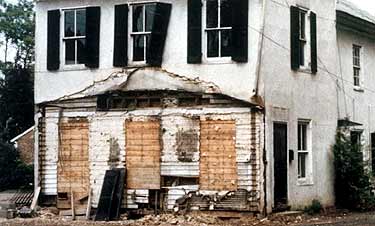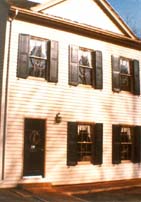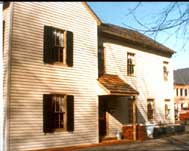



no.1
 If historic features are deteriorated and missing,
If historic features are deteriorated and missing,
DON'T end up with an all new building!
::issueFOCUS:: Replacing historic materials
::go to REHAB YES'S::
[TOP IMAGE] Deteriorated, still significant. NPS Photos.
The historic character...
This two-story frame house built around 1870 is severely deteriorated--the
lap siding has been covered with stucco; a later front porch, non-significant
front and rear additions, and an exterior metal staircase leading to the
second floor have all been removed. But, in spite of the degree of exterior
loss and change, the essential form and detailing of the house is sufficiently
intact to convey its historical significance within the district before
rehab.
|
...and how it was lost in the rehabilitation.
First, the nonhistoric stucco was removed. The owner felt the historic
lap siding was deteriorated beyond repair due to moisture and termites,
and, as a result, removed all of it as well as the sheathing underneath.
At the same time, other historic wood features were removed and replaced,
including all roofing, all windows, shutters, and wood trim. In addition
to the sheer amount of new material introduced, some of the replacement
features were inappropriate, such as the thick wood-shingle roofing. The
cumulative effect of the rehabilitation was to create an all new house
with some Colonial style details that would never exist on an 1870s house.
Because of the wholesale replacement of materials and features, and lack
of documentation for the new work, the rehabilitation did not meet Standards
2 and 6. Further, the building was no longer considered "historic,"
and was removed from the National Register of Historic Places.
What should you know?
Rehabilitation work may reasonably involve repair or even total replacement
in kind of some particularly deteriorated historic materials, such as
roofing, exterior wood cladding, wood window frames and sash, or interior
plaster. But historic features that can be repaired and preserved
should not be removed and replaced with new material. Physical or pictorial
documentation should always precede replacement of missing historic features.

Replaced shutters,
roofing, windows, trim...
Standard 2: The historic character of a property shall be retained and preserved. The removal of historic materials or alteration of features and spaces that characterize a property shall be avoided.
Standard 6: Deteriorated historic features shall be repaired rather than replaced. Where the severity of deterioration requires replacement of a distinctive feature, the new feature shall match the old in design, color, texture, and other visual qualities and, where possible, materials. Replacement of missing historic features shall be substantiated by documentary, physical, or pictorial evidence.

